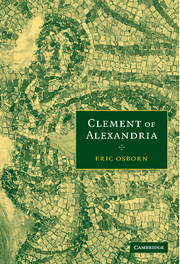Book contents
- Frontmatter
- Contents
- Preface
- List of abbreviations
- 1 Life and works
- PART I DIVINE PLAN/ECONOMY
- PART II DIVINE RECIPROCITY
- PART III FAITH AND SALVATION
- Conclusion
- Appendix: Irenaeus and Clement
- Select Bibliography
- Subject index
- Citations from Clement
- Citations from the Bible
- Citations from ancient authors
Appendix: Irenaeus and Clement
Published online by Cambridge University Press: 06 July 2010
- Frontmatter
- Contents
- Preface
- List of abbreviations
- 1 Life and works
- PART I DIVINE PLAN/ECONOMY
- PART II DIVINE RECIPROCITY
- PART III FAITH AND SALVATION
- Conclusion
- Appendix: Irenaeus and Clement
- Select Bibliography
- Subject index
- Citations from Clement
- Citations from the Bible
- Citations from ancient authors
Summary
Second-century Christian thought is concerned to find and declare the unity of the New Testament. Irenaeus, like Clement and Tertullian, saw the Christian bible as dependent upon the proclamation of good news in Jesus Christ. If there was unity to be found in these writings, it would be through the gospel or kerygma that governed their selection.
While the apostolic kerygma is not set out in one fixed formula, if we look at the sermons of Acts, there is a clear pattern. The one God has created all things. From the beginning his plan has guided his people, instructing them and drawing them nearer to himself. All that is said of God and of his promised deliverance is fulfilled in Jesus Christ. Here the many strands of prophetic witness come together. This fulfilment is salvation for humankind and in it all may participate by faith.
The fourfold pattern may be discerned quite plainly at the beginning of the Letter to the Hebrews. Scripture confirms kerygma, and kerygma holds scripture together.
Irenaeus finds in the Christian kerygma these concepts: one God as the omnipresent intellect whose goodness governs all things (haer. 2.10.3; 3.25.3); the economy (oikonomia) or plan of creation and salvation; recapitulation, the summing up of all things in Christ, who corrects and perfects mankind, inaugurating a new humanity (haer. 3.18.6; 3.19.3); and participation, by which man receives the salvation planned by God and fulfilled in Christ. Adam never left the hands of God (haer. 5.1.3).
- Type
- Chapter
- Information
- Clement of Alexandria , pp. 282 - 292Publisher: Cambridge University PressPrint publication year: 2005



